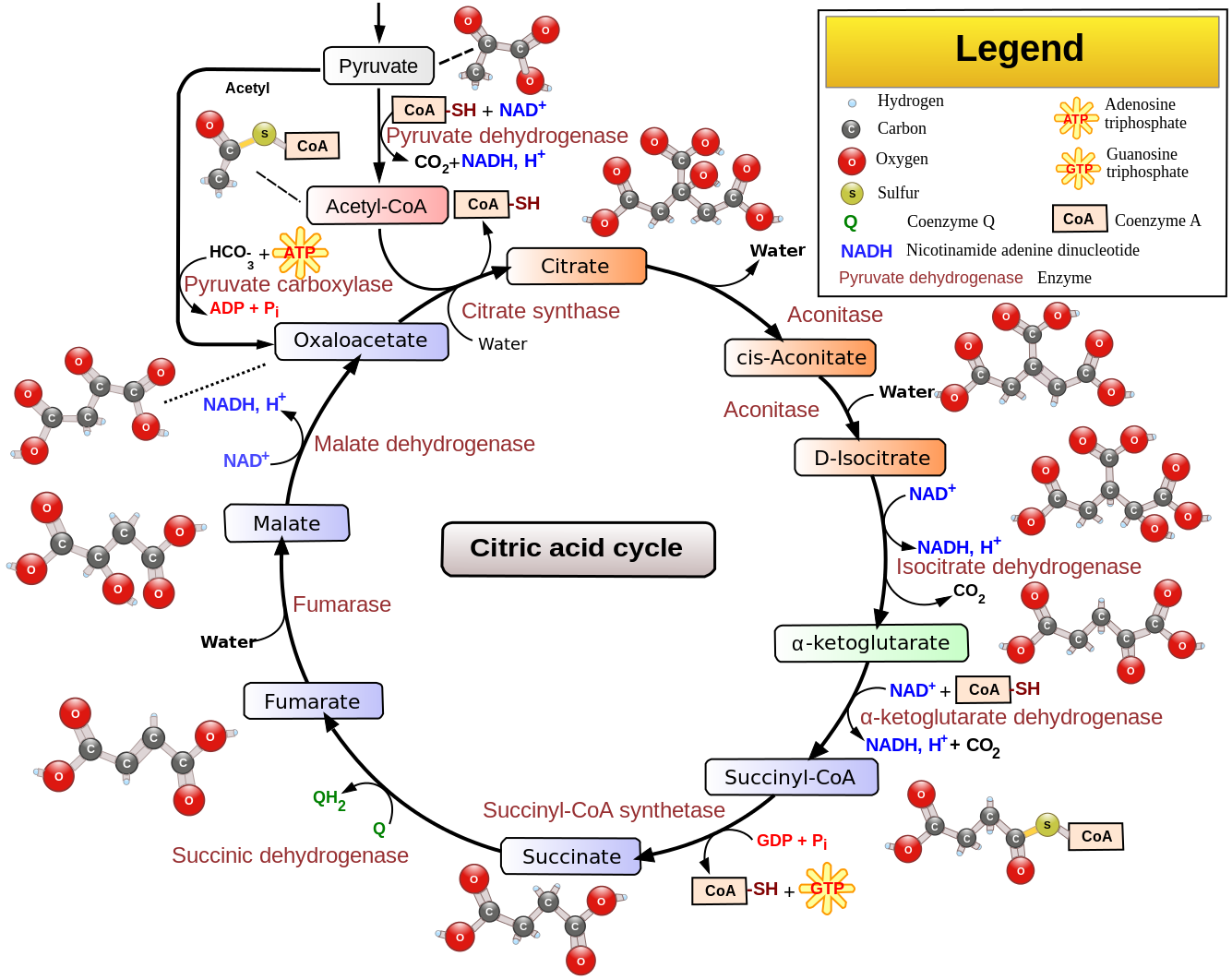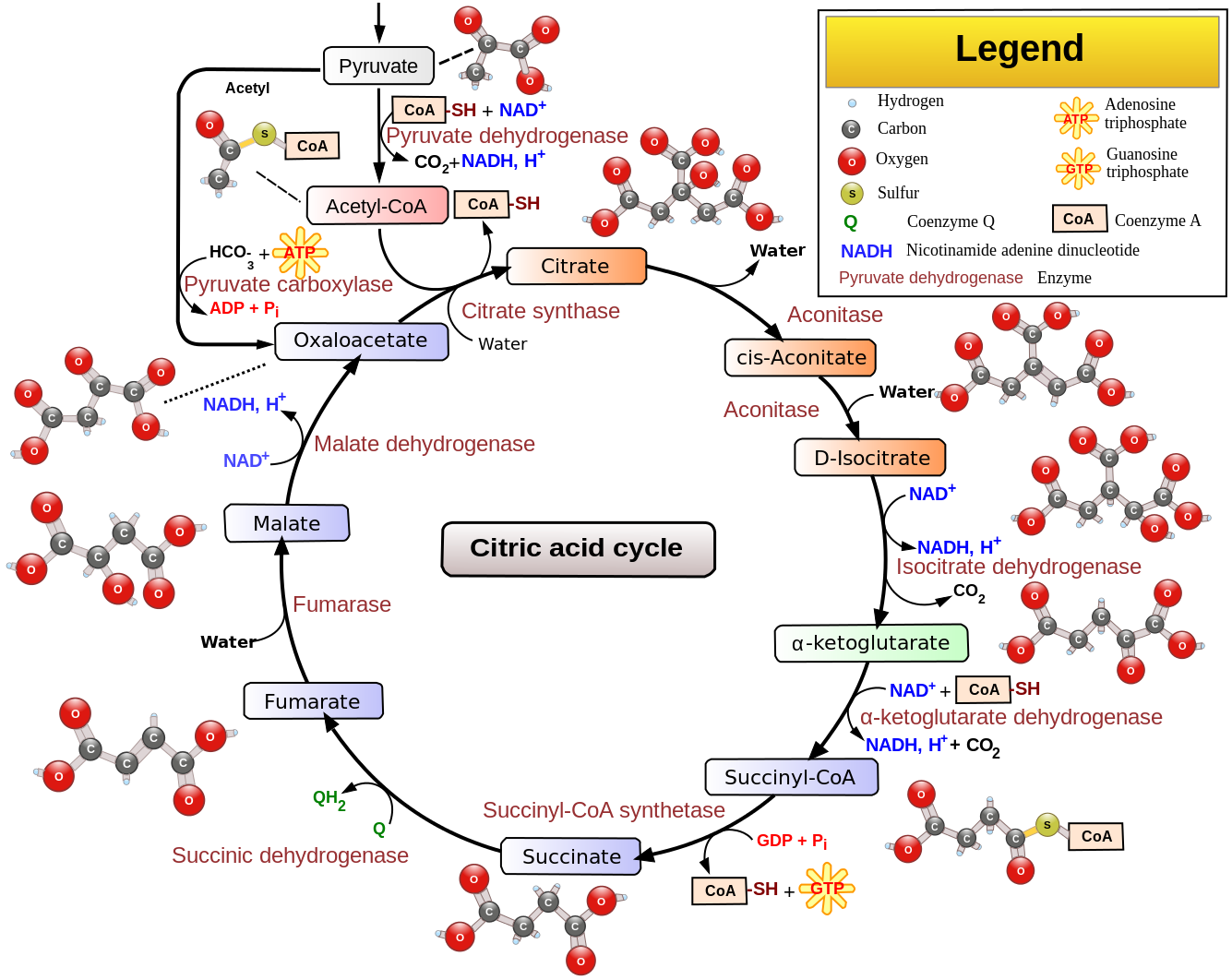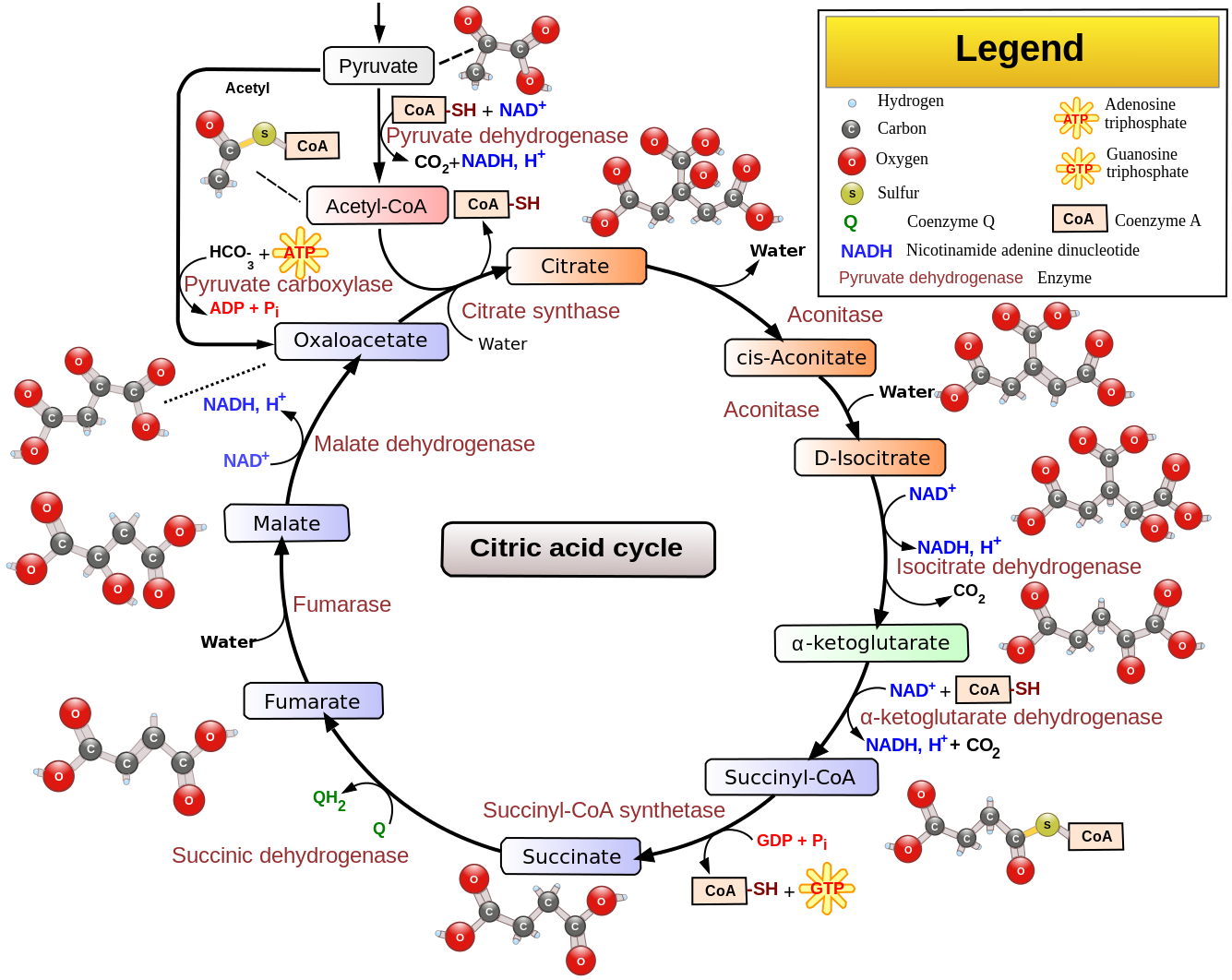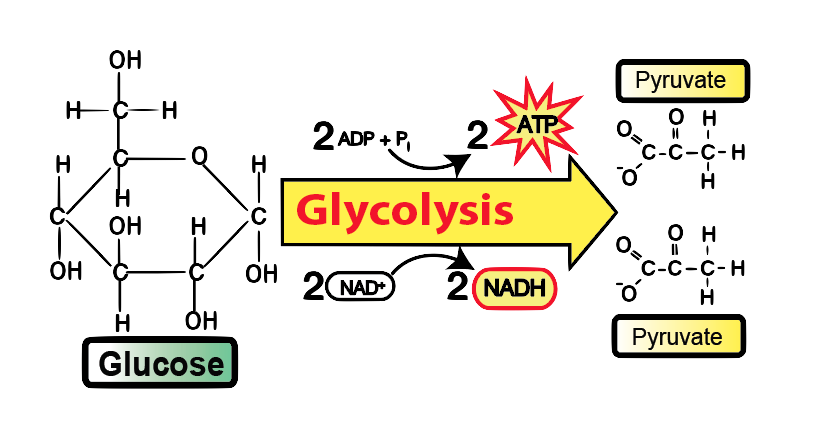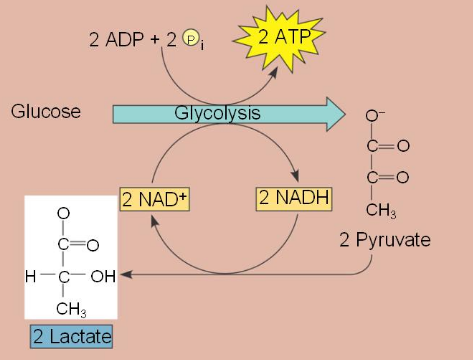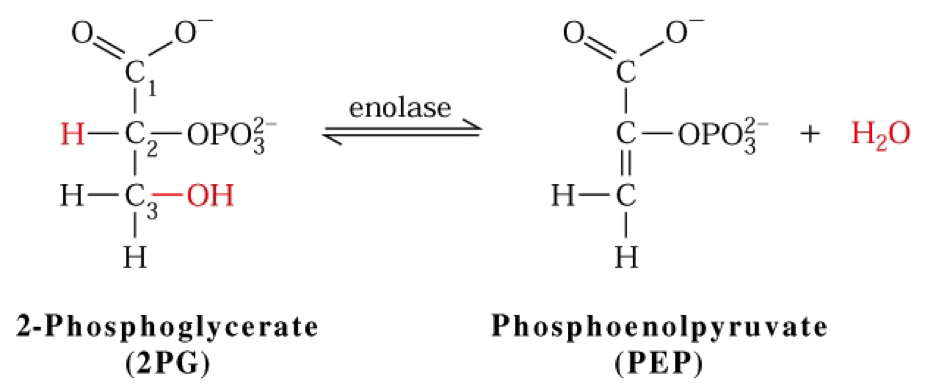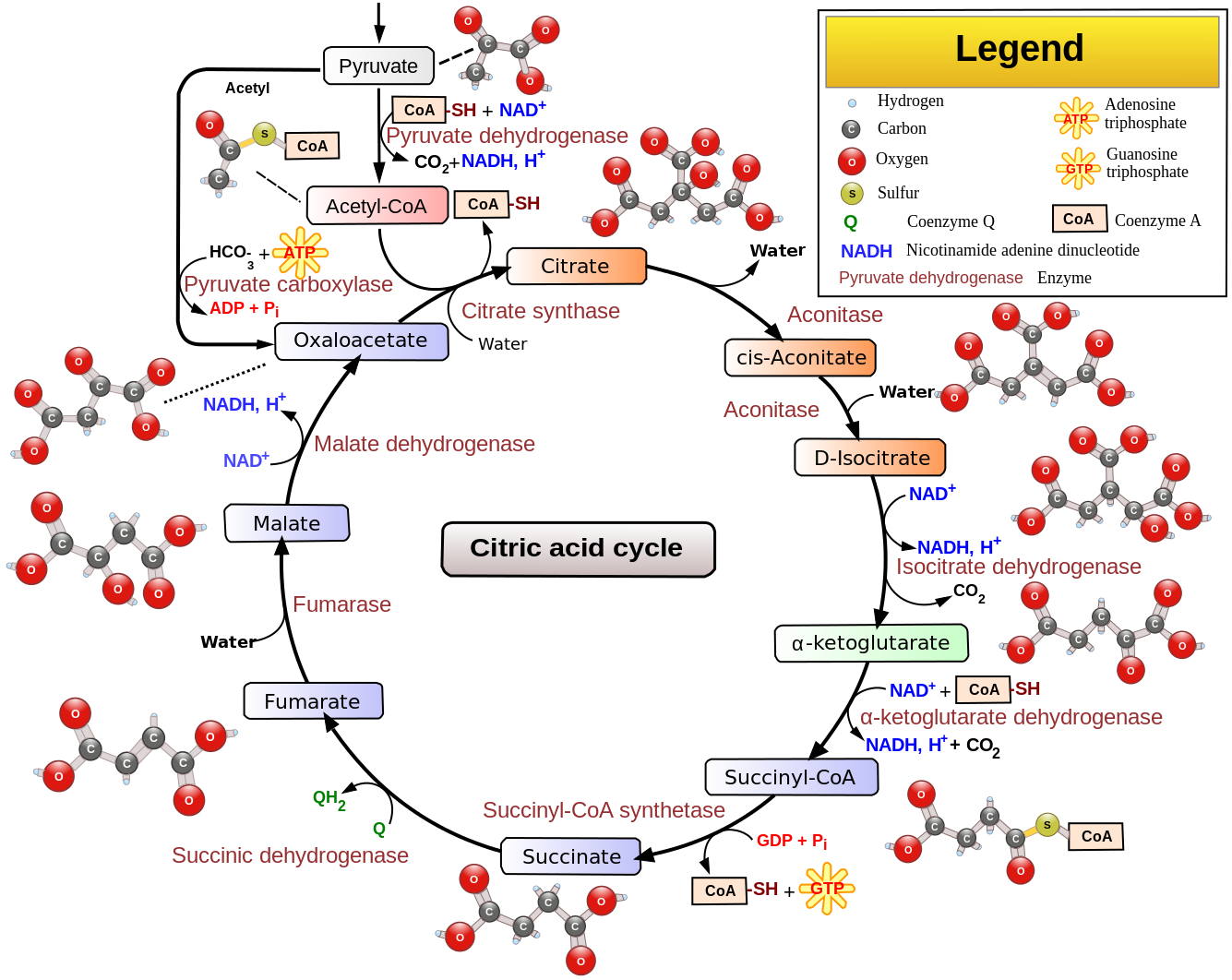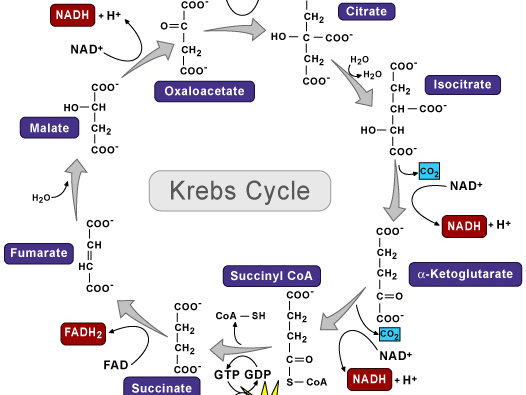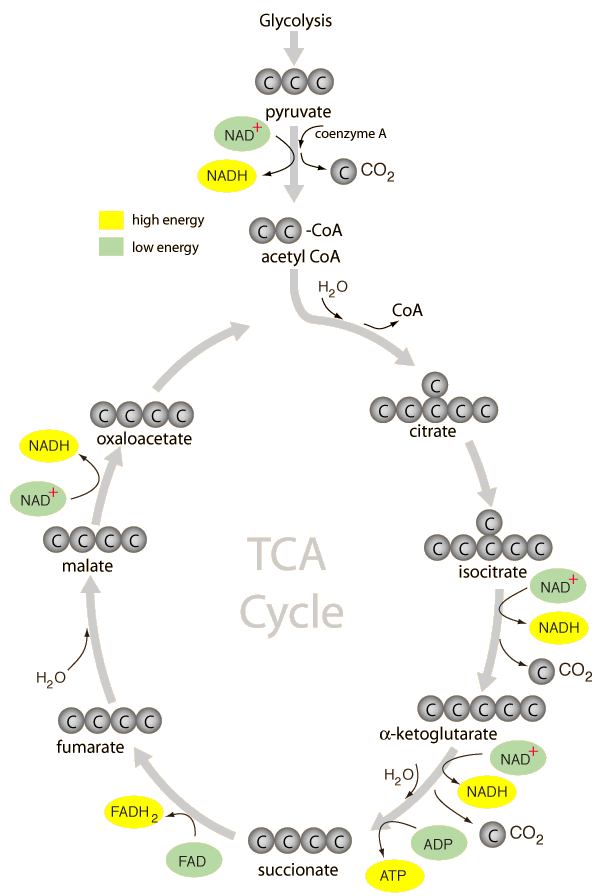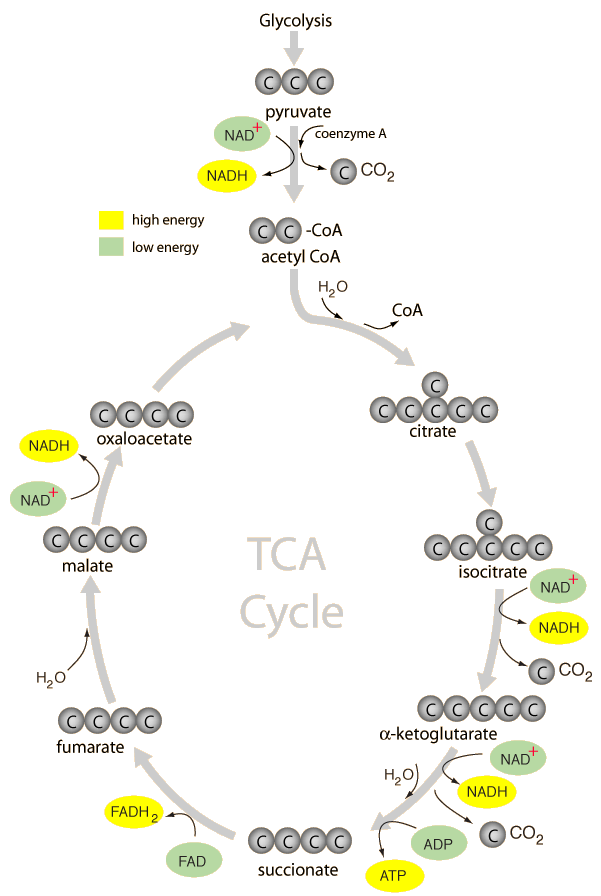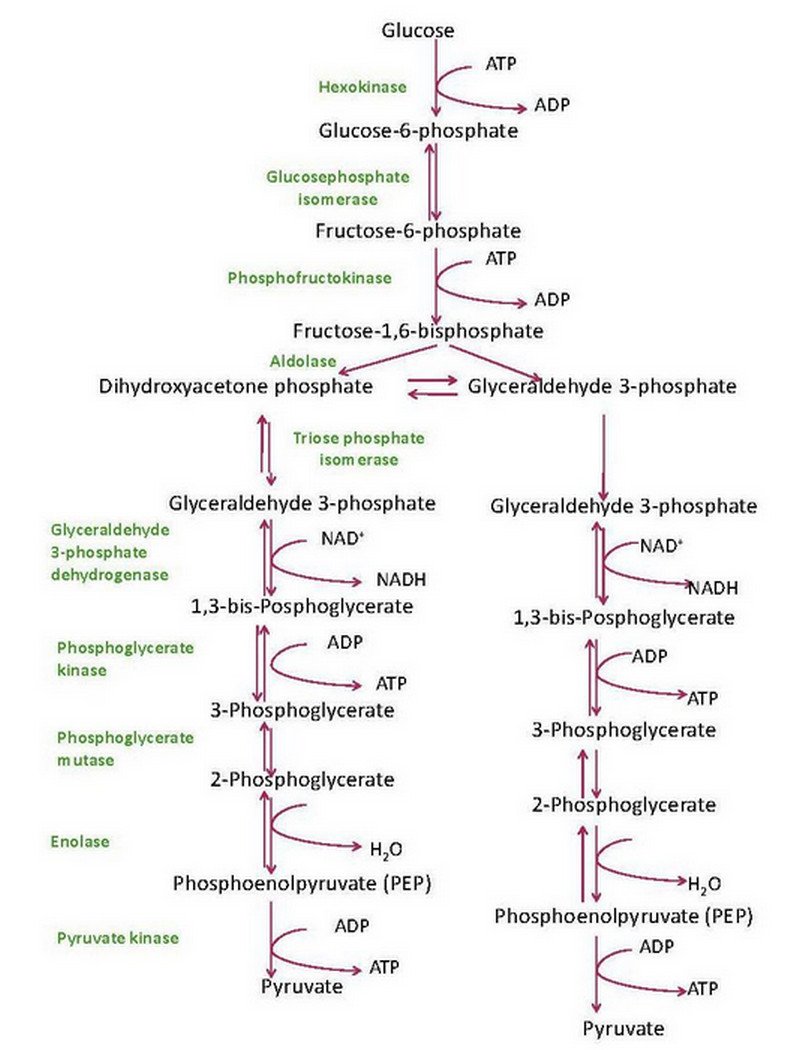Q.1.
Choose the correct combination of labelling the number of carbon compounds in the substrate molecules, involved in the citric acid cycle.
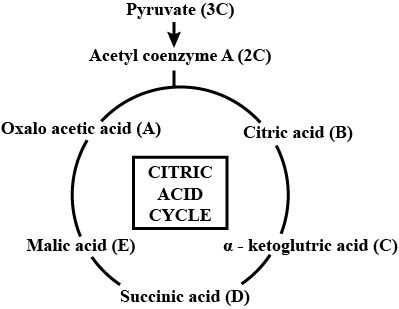

-
0%
(A)4C, (B)6C, (C)5C, (D)4C, (E)4C
-
0%
(A)6C, (B)5C, (C)4C, (D)3C, (E)2C
-
0%
(A)2C, (B)5C, (C)6C, (D)4C, (E)4C
-
0%
(A)4C, (B)6C, (C)6C, (D)4C, (E)5C
-
0%
(A)4C, (B)6C, (C)4C, (D)4C, (E)4C
Q.2.
In Krebs cycle the FAD participates as electron acceptor during the conversion of
-
0%
Succinyl CoA to succinic acid
-
0%
$$\alpha -$$ ketoglutarate to succinyl CoA
-
0%
Fumaric acid to malic acid
-
0%
Succinic acid to fumaric acid
Q.3.
Which of these steps in Krebs cycle indicates substrate level phosphorylation?
-
0%
Conversion of succinic acid to $$\alpha $$-ketoglutaric acid
-
0%
Conversion of succinic acid to malic acid
-
0%
Conversion of succinyl CoA to succinic acid
-
0%
Conversion of malic acid to oxaloacetic acid
-
0%
Conversion of citric acid to $$\alpha -$$ketoglutaric acid
Q.4.
Which of the following is produced during Krebs cycle?
-
0%
Citric acid
-
0%
Lactic acid
-
0%
Acetyl coenzyme A
-
0%
Acetic acid
Q.5.
Which one of the following energy storing compound is formed when succinyl CoA is converted into succinic acid?
-
0%
ADP
-
0%
ATP
-
0%
AMP
-
0%
GTP
Q.6.
The pyruvic acid formed in glycolysis is oxidized to C$$O_{2}$$ and H$$_{2}$$O in a cycle called as
-
0%
Calvin cycle
-
0%
Hill reaction
-
0%
Kreb's cycle
-
0%
Nitrogen cycle
Q.7.
Which of the following are X, Y and Z in the given schematic diagram?
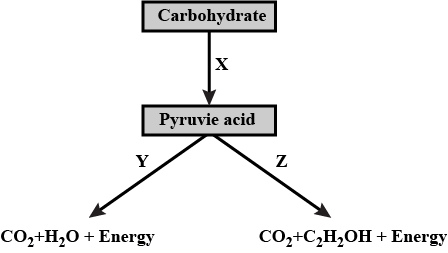

-
0%
X - Glycolysis, Y - Anoxybiotic, Z - Oxybiotic
-
0%
X - Kreb''s cycle, Y - Oxybiotic, Z - Anoxybiotic
-
0%
X - Glycolysis, Y - Oxybiotic, Z - Anoxybiotic
-
0%
X - Glycolysis, Y - Oxybiotic, Z - Kreb''s cycle
Q.8.
$${Q_{10}}$$ is
-
0%
Respiratory coefficient
-
0%
Photosynthetic coefficient
-
0%
Photosynthetic yield
-
0%
Temperature coefficient
Q.9.
Aerobic respiratory pathway is appropriately termed :-
-
0%
Anabolic
-
0%
Catabolic
-
0%
Parabolic
-
0%
Amphibolic
Q.10.
The energy-releasing metabolic process in which substrate is oxidised without an external electron acceptor is called
-
0%
Glycolysis
-
0%
Fermentation
-
0%
Aerobic respiration
-
0%
Photorespiration
Q.11.
Enzymes for glycolysis are present in:
-
0%
Cytoplasm
-
0%
Nucleoplasm
-
0%
Mitochondria
-
0%
Golgi vesicles
Q.12.
The experiment to show that $$CO_{2}$$ is given out during respiration, the type of respiration is
-
0%
anaerobic
-
0%
aerobic
-
0%
both (a) and (b)
-
0%
neither (a) and (b)
Q.13.
All enzymes of TCA cycle are located in the mitochondrial matrix except one which is located in inner mitochondrial membranes in eukaryotes and in cytosol in prokaryotes. This enzyme is:-
-
0%
Succinate dehydrogenase
-
0%
Lactate dehydrogenase
-
0%
Isocitrate dehydrogenase
-
0%
Malate dehydrogenase
Q.14.
Mitochondria is the site for
-
0%
Krebs cycle
-
0%
Calvin cycle
-
0%
Anaerobic respiration
-
0%
Trapping of sun light
Q.15.
The site of Krebs cycle is
-
0%
Cytoplasm
-
0%
Mitochondrial matrix
-
0%
Intermembrane space of mitochondria
-
0%
Racker's particles
Q.16.
Which of the following gaseous exchange occurs in leaves of plant at the time of respiration?
-
0%
Oxygen diffuses out.
-
0%
Oxygen diffuses in.
-
0%
Carbon dioxide diffuses out.
-
0%
Carbon dioxide diffuses in.
Q.17.
During respiration pyruvic acid is formed by
-
0%
Glycolysis
-
0%
Kreb's cycle
-
0%
HMP pathway
-
0%
All of the above
Q.18.
Fermentation is represented by the equation
-
0%
$${C_6 H _{12}O_6+6 O_2\overset{light}{\rightarrow}6CO_2+H_2O +673 kcal}$$
-
0%
$${C_6 H _{12}O_6+\rightarrow 2C_2H_5 OH+2CO_2 +18 kcal}$$
-
0%
$${6 CO _2+12 H_2 O\overset{Chlorophyll}{\rightarrow} C_6 H_{12}O_6 +6H_2 O+6O_2}$$
-
0%
$${6 CO_2+6 H_2 O\rightarrow C_6 H_{12}O_6+6O_2}$$
Q.19.
The importance of the Kreb's cycle is
-
0%
Production of amino acid
-
0%
Production of vitamin
-
0%
Production of ATP molecule through oxidative phosphorylation
-
0%
ATP formation through oxidative and substrate level phosphorylation
Q.20.
The number of photons required to release one mole of $${O_2}$$ in photosynthesis is called as
-
0%
Quantum yield
-
0%
Quantum requirement
-
0%
Red drop
-
0%
Emerson's effect
Q.21.
The end product of fermentation of sugars by Lactobacillus bacteria is
-
0%
Lactic acid.
-
0%
$${CO_2}$$.
-
0%
Methyl alcohol and $${CO_2}$$.
-
0%
Butyl alcohol.
Q.22.
For the enzyme enolase, the substrate is
-
0%
Succinic acid
-
0%
PGA
-
0%
PEP
-
0%
Fumaric acid
Q.23.
How many electrons are involved for the formation of 1 mole of glucose and 6$$O_{2}$$ molecules?
-
0%
6
-
0%
12
-
0%
18
-
0%
24
Q.24.
Kreb's cycle starts with the formation of a six carbon compound by the reaction between
-
0%
Malic acid and acetyl Co-A.
-
0%
Succinic acid and pyruvic acid.
-
0%
Fumaric acid and succinyl Co-A.
-
0%
Oxaloacetic acid and acetyl Co-A.
Q.25.
Fermentation is carried out by
-
0%
All bacteria
-
0%
All fungi
-
0%
Some bacteria and some fungi
-
0%
All micro-organisms
Q.26.
Which of the following sequence is correct in Krebs cycle?
-
0%
Oxaloacetic acid, malic acid, citric acid
-
0%
Malic acid, citric acid, oxaloacetic acid
-
0%
Fumaric acid, malic acid, oxaloacetic acid
-
0%
All of the above
Q.27.
In CAM the R.Q will be
-
0%
Zero
-
0%
1
-
0%
More than one
-
0%
Less than one
Q.28.
Which of the metabolites is common to respiration mediated breakdown of fats and carbohydrates?
-
0%
Fructose -1 ,6 bisphosphate
-
0%
Malic acid
-
0%
Acetyl CoA
-
0%
Glucose - 6 -phosphate
Q.29.
Before combining with the oxaloacetic acid of citric acid cycle the pyruvic acid changes into
-
0%
4 carbon compound
-
0%
3 carbon compound
-
0%
2 carbon compound
-
0%
6 carbon compound
Q.30.
If man consumes only carbohydrate, the R.Q. will be
-
0%
1
-
0%
0.7
-
0%
0
-
0%
4
Q.31.
Pyruvic dehydrogenase is used in converting _________________.
-
0%
Pyruvic acid to acetyl co-enzyme A
-
0%
Pyruvate to glucose
-
0%
Glucose to pyruvate
-
0%
Pyruvic acid to lactic acid
Q.32.
Respiratory quotient is
-
0%
More than one for organic acids.
-
0%
Less than one for proteins.
-
0%
Equal to zero for CAM plants at night.
-
0%
All of the above.
Q.33.
During aerobic cycle how many metabolic steps release $${O_2}$$?
-
0%
One
-
0%
Twelve
-
0%
Six
-
0%
None of the above
Q.34.
All of the following are prosthetic groups in conversion of pyruvate to acetyl CoA reaction, except
-
0%
Mn
-
0%
Thiamine pyrophosphate and coenzyme A
-
0%
Lipoic acid
-
0%
NAD
Q.35.
Which reaction leads to direct formation of ATP in Kreb's cycle?
-
0%
Glucose -1 -phosphate to glucose -6-phosphate
-
0%
Citrate to isocitrate
-
0%
Ketoglutarate to succinate
-
0%
Isocitrate to cis-aconitate
Q.36.
Protein rich pulses have R.Q. will be
-
0%
One
-
0%
More than one
-
0%
Less than one
-
0%
None of the above
Q.37.
In TCA during the conversion of succinic acid to fumaric acid how many ATP are produced?
-
0%
2
-
0%
14
-
0%
6
-
0%
10
Q.38.
The form in which carbon leaves the citric acid cycle is
-
0%
Acetaldehyde
-
0%
Ethanol
-
0%
Lactate
-
0%
Carbon dioxide
Q.39.
The enzymes of EMP are located in
-
0%
Cytosol
-
0%
Cytosol and mitochondria
-
0%
Lysosomes
-
0%
Ribosomes
Q.40.
In which one of the following do the two names refer to one and the same thing?
-
0%
Kreb's cycle and Calvin cycle
-
0%
Tricarboxylic acid cycle and citric acid cycle
-
0%
Citric acid cycle and Calvin cycle
-
0%
Tricarboxylic acid cycle and urea cycle
Q.41.
In alcoholic fermentation
-
0%
Triose phosphate is the electron donor, while acetaldehyde is the electron acceptor.
-
0%
Triose phosphate is the electron donor, while pyruvic acid is the electron acceptor.
-
0%
There is no electron donor.
-
0%
Oxygen is the electron acceptor.
Q.42.
R.Q of the succulents can be
-
0%
0
-
0%
1
-
0%
0.7
-
0%
Both (A) and (B)
Q.43.
When one molecule of glucose is completely oxidized during aerobic respiration, how many molecules of carbon dioxide are released due to tricarboxylic acid cycle?
-
0%
1
-
0%
2
-
0%
3
-
0%
4
Q.44.
Krebs cycle is called aerobic because
-
0%
Some of the enzymes require oxygen.
-
0%
All of the enzymes require aerobic media.
-
0%
Oxygen is released during this cycle.
-
0%
Some of the products of this cycle have to be oxidized.
Q.45.
Acetyl CoA is synthesized in the
-
0%
Cytosol
-
0%
Inner membrane of mitochondria
-
0%
Matrix of mitochondria
-
0%
$${F_1}$$ particles of mitochondria
Q.46.
The last acid produced in the Kreb's cycle of aerobic respiration
-
0%
Oxaloacetic acid
-
0%
Malic acid
-
0%
a- ketoglutaric acid
-
0%
Succinic acid
Q.47.
$${2C_{51}H_{98}O_6+146 O_2\rightarrow 102 CO_2 +98 H_2 O}$$, the R.Q for the above reaction is
-
0%
0.7
-
0%
1
-
0%
1-45
-
0%
1-62
Q.48.
All the reactions in glycolysis are reversible except
-
0%
3-Phosphoglycerate to 1,3-Biphosphoglycerate.
-
0%
Glucose 6-phosphate to fructose -6-phosphate.
-
0%
1,3-Biphosphoglycerate to glyceraldehyde 3-P.
-
0%
Fructose -6-phosphate to fructose-1,6-diphosphate.
Q.49.
Which one of the following represents fermentation?
-
0%
$${C_6H_{12}O_6\xrightarrow[enzyme]{yeast}CH_3COOH+H_2O}$$
-
0%
$${C_6H_{12}O_6\xrightarrow[enzyme]{yeast}C_2H_5OH+CO_2}$$
-
0%
$${C_6H_{12}O_6\rightarrow CH_3OH+H_2O}$$
-
0%
$${C_6H_{12}O_6\xrightarrow[enzyme]{yeast}CH_3COOH+H_2O+CO_2}$$
Q.50.
Respiratory quotient of which of the following diet is less than unity?
-
0%
Carbohydrate
-
0%
Fats
-
0%
Organic acid
-
0%
Sugar
